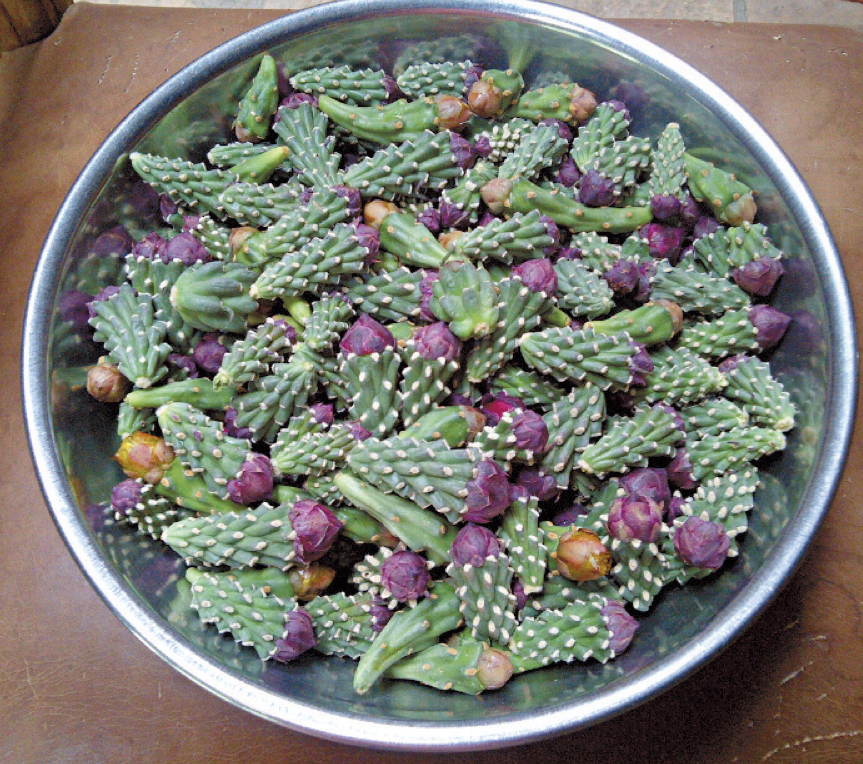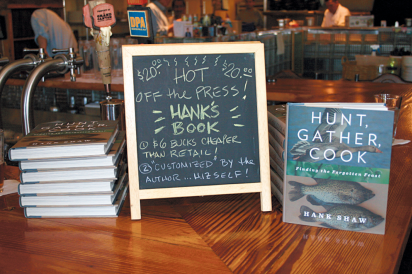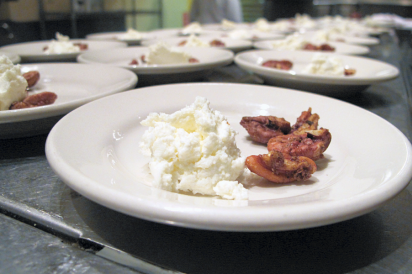Harvesting the Desert: Take a Walk on the Wild Side
Local, seasonal, organic–sound familiar? It's a rallying cry heard around the country from farmers' markets to the White House.
Now Hank Shaw wants us to add "wild" to the mix, as in local, seasonal, wild.
Shaw, a former journalist based in Sacramento, is the author of a new book called Hunt, Gather, Cook: Finding the Forgotten Feast. He is the force behind the wildly (pardon the pun) popular food blog Hunter Angler Gardener Cook (twice-nominated for a James Beard Award and winner of the Bert Greene Best Food Blog Award from the International Association of Culinary Professionals for two years in a row).
Called a modern day Euell Gibbons, Shaw has been at the forefront of a nationwide effort to revitalize a historical method of gathering food: foraging what is all around us. He is on a mission to spread the foraging gospel from coast to coast.
There's a New Forager in Town
Shaw made his first visit to the Valley recently, as part of a cross-country book tour, for a five-course dinner paired with Arizona wines hosted by Chef Chrysa Robertson of Rancho Pinot in Scottsdale.
Robertson has been at the helm of her seasonally inspired, cowboy-kitsch restaurant since 1993. She started the Phoenix Chapter of Slow Food USA, and was recently inducted into the Scottsdale Culinary Hall of Fame.
She is no stranger to local, seasonal, organic– or wild for that matter–but she says Shaw's trip reminded her of the wealth of bounty in her own backyard, both literally and figuratively.
For years, Robertson has harvested prickly pear from the cacti garden outside her home and picked mulberries from an old east Phoenix family home to create syrups she uses in her restaurant's drinks and in sweet and savory sauces. She routinely builds her menu with items grounded in agriculture from across the Grand Canyon state: meats, cheeses, produce, nuts and honey.
Shaw and Robertson collaborated on a menu for the dinner that, in addition to promoting Shaw's book, introduced diners to the usual–and some unusual–ingredients found in the state of Arizona. Although not all ingredients were specifically harvested from the wild, the duo highlighted the potential for foraging food from the surrounding area.
Shaw is not a chef, although he did work his way up from dishwasher to sous chef in an Ethiopian restaurant while he was working on his graduate degree in African History–and he did a short stint as a line cook in a fish restaurant, where he learned to filet fish with precision versus the typical fisherman's hack job. He is the first to admit he's "more writer than cook," so he left the actual cooking for his foraged dinner in Robertson's hands.
"Chrysa is very down to earth and her cooking is unpretentious," Shaw says. "I like that. I'm really happy with someone who fully embraces the ingredients," he says, while admitting his own cooking style is more formal.
Robertson was a gracious host. She put Shaw up in her home for his trip to Phoenix, and the two toured her expansive, native desert garden.
"She's got jojoba, and I told her she should eat those goat nuts," Shaw says, explaining that the jojoba seedpods are called goat nuts because, well, goats eat them. Had they been ready for harvest, they might have appeared on the menu.
Dining off the Land
Cholla buds were in season during Shaw's visit and Robertson scoured the desert, plucking the buds with long tongs from spindly cacti for the dinner.
"Native ingredients are nutrient powerhouses," Robertson says. Cholla buds are high in calcium and contain soluble pectin, which helps manage blood sugar levels.
The buds are covered in barbed spines that must be removed before eating. Robertson researched how Native Americans, who have been eating desert plants for thousands of years, traditionally removed the prickly stickers: rubbing the buds in gravel with primitive brooms. She coerced her partner into a modern-day version of the process: rubbing the buds on a mesh screen with a scrub brush until all the offending spikes fell off.
For the dinner, Robertson briefly boiled the barbless cholla buds and then sautéed them in hot oil, creating a roasted, almost sunchoke flavor. The brief boil followed by the hot pan roasting also helped reduce the somewhat "okra-slime" mucilage characteristic of the cholla buds. She paired the roasted cholla buds in the third course with an elderberry-glazed roasted quail with mole verde, using elderberries she personally harvested in Sunflower, Arizona.
Cholla buds and elderberries weren't the only ingredients Robertson hand-harvested. She turned venison from a family member into sausage, using copious amounts of juniper berries picked on a trip to Young, Arizona, northeast of the Valley.
Although not all the ingredients for the dinner were hand-harvested, the essence of local foraging was honored, with the quail and with the blue cornmeal crusted trout served in the second course with a mélange of native tepary beans, grilled nopales (cactus pads), local spring onions, corn and bacon.
Another ingredient, although representing the spirit of local foraging, came from outside of Arizona. Shaw told Robertson about the Emory Oak, a tree common in the Southwest and specifically in southeastern Arizona, and suggested she use Emory acorn meal in one of the courses.
"Other acorns have high levels of tannins that have to be leeched out, but you don't have to do that with the Emory oak," Shaw says. "It has one of the lowest levels of tannins so you can just roast the acorns and eat them."
Robertson tried to locate the Emory meal locally but had to settle for acorn meal from California. She turned the "imported" acorn meal into piadini, a griddled flatbread for the appetizer course, served with the Arizona venison sausage and fried squash blossoms, snipped from hard winter squashes called guarijio, originally grown by the Tohono O'odham tribe and supplied by a local farmer.
For the cheese course, the wild pecan honey drizzled on Arizona Black Mesa Ranch goat cheese came from a beekeeper based in Black Canyon City, and the candied pecans were harvested from Carole Steele's pecan grove at Aravaipa Farms in Southern Arizona.
Dessert had a heavy local slant, too: folded crepes made with mesquite flour from Tucson filled with local peaches turned into ice cream and sprinkled with native wild chiltepin chile.
"Local flours are pretty much everywhere," says Shaw. "The Desert Southwest has three native flours: mesquite, chia and amaranth, which grows as a weed here."
Learning to Forage
How do you learn how to forage? Shaw says it's helpful if you have someone show you, but says he's learned about areas he isn't familiar with through reading books.
"I've never lived in the desert, so I started with books and then ordered some products online," he says. "There's a thing about wild plants–you don't see them until you see them."
Robertson plans to work more foraged ingredients into her menu, including the labor-intensive cholla buds. And she says she's now more aware of the foodstuffs found in the natural desert surrounding her.
Shaw's message seems to be taking root. Before he left town for his next tour stop, he made a simple request: Take a walk on the wild side.
Foraged Feast at Rancho Pinot, Featuring Hank Shaw
Aperitif:
Mulberry Elixir de Travis Black Mesa Ranch goat cheese-piñon savory wafers
Appetizer 'Tidbits':
Crispy guarijio squash blossom, sweet-n-sour i'itoi onions, sautéed shishito peppers, acorn meal piadini, venison sausage Carlson Creek '09 Sauvignon Blanc
Trout:
New Mexico blue cornmeal-crusted on a salad of tepary beans, mesquite grilled nopales, spring onion, corn and bacon with Mexican oregano vinaigrette Page Springs Cellars '08 El Mezcla Primo Grenache-Syrah blend
Quail:
Elderberry glazed and mesquite grilled with cholla buds, chayote and local summer squash, mole verde Arizona Stronghold '09 Mangus Sangiovese-Cab blend
Cheese:
Black Mesa Ranch fresh chèvre with wild pecan honey, Carol's sweet-n-spicy Aravaipa-grown pecans
Dessert:
Mesquite flour crepes with local peach ice cream dusted with Sonoran chiltepin pepper and prickly pear-mesquite honey sauce
Contacts
Hunter Angler Gardener Cook blog
Hunt, Gather, Cook: Finding the Forgotten Feast by Hank Shaw; May, 2011; Rodale
Rancho Pinot
6208 North Scottsdale Road, Scottsdale
480-367-8030
Books for further reading
Gathering the Desert
by Gary Paul Nabhan
Food Plants of the Sonoran Desert
by Wendy C. Hodgson







